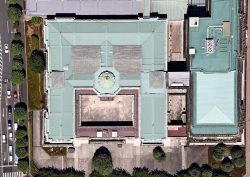
Masako Nagano, a pediatric ophthalmologist, examines a child at the Inoue Eye Hospital in Chiyoda Ward, Tokyo, in mid-March.
10:02 JST, April 7, 2021
Myopia, or nearsightedness as the condition is colloquially known, is being eyed as another potential side effect of the pandemic as children spend more time glued to the screens of smartphones and computers at home.
While an increase in juvenile myopia has been observed worldwide, accurate data has not been available for children in Japan, as the condition has not been a focus of school physical exams.
Beginning this month, the Education, Culture, Sports, Science and Technology Ministry plans to conduct its first comprehensive study of myopia in elementary and junior high school students, in an effort to gain a clearer picture of myopia’s growing prevalence nationwide.
“I’ve noticed that writing on the classroom blackboard often looks more blurry than before,” said a junior high school student in Chiyoda Ward, Tokyo. Six months into the novel coronavirus outbreak, the 13-year-old’s vision had worsened to the point that he had to have a new glasses prescription filled.
As the pandemic dragged on, his school began offering online classes once a week on a tablet. Unable to meet up with friends in person, he began spending more time exchanging messages on his phone. When the state of emergency was declared in January, soccer club practice also moved online with remote coaching sessions.
He spends two to three hours a day looking at screens. “I’m careful to keep enough distance between my eyes and the devices, but I just want to be able to play outside again, without having to worry about this stuff,” he said.
Inoue Eye Hospital, the boy’s eye care provider in Chiyoda Ward, has been diagnosing more myopia in elementary and junior high school students since June last year, shortly after schools closed for the first state of emergency that was in effect last April and May.
Masako Nagano, 56, a pediatric ophthalmologist at the hospital, said, “I suspect a cause-and-effect connection between the increase [in myopia] and the pandemic, as kids spend more time on their phones, tablets and other devices.”
Same situation in China
In October, Rohto Pharmaceutical Co. conducted a nationwide survey of 352 mothers in their 30s and 40s with children elementary school-aged or older.
The survey found that 24.4% of the mothers felt their children’s eyesight had become worse over the course of the pandemic, while more than 60% of the respondents estimated that their children were spending an additional hour or more than before on their phones and other digital devices each day.
Myopia is becoming increasingly common on a global scale, particularly in East Asia. The World Health Organization estimates that half of the world’s population will be nearsighted by 2050 and warns that urgent steps are needed for treatment and prevention.
A survey conducted at an elementary school in China’s Shandong Province, where schools were closed and curfews in effect, showed that the percentage of 6-year-olds with myopia had nearly quadrupled to 21.5% last year, up from 5.7% in 2019.
Survey of 9,000 students
Poor eyesight among children in Japan is a problem that predates the pandemic. However, this year marks the first time the ministry will specifically investigate for myopia and astigmatism in 9,000 elementary and junior high school students, an age group that is said to be experiencing a rapid decline in eyesight, in a survey that is set to start this month.
The ministry plans to also conduct questionnaires to gauge the students’ use of digital devices, as well as time spent reading and outdoors.
“We hope the study will provide a clearer understanding of the correlation between juvenile myopia and lifestyle habits, which will allow us to explore more effective measures in response,” a ministry official said.
Risks
As myopia progresses, it can stretch the optic nerve and retina, increasing the risk of glaucoma and retinal detachment.
Kyoko Ohno, a specialist in childhood myopia at the Tokyo Medical and Dental University, said, “To prevent the onset and progression of myopia, it’s important not to overly burden your eyes.”
Specific preventive measures include: spend two hours outside each day; when reading, keep books at least 30 centimeters away from your eyes and look away into the distance once every 20 minutes; and adjust the lighting so that it is neither too bright nor too dark.
"Society" POPULAR ARTICLE
-

M4.9 Earthquake Hits Tokyo, Neighboring Prefectures
-

M7.5 Earthquake Hits Northern Japan; Tsunami Waves Observed in Hokkaido, Aomori and Iwate Prefectures
-

Tsukiji Market Urges Tourists to Avoid Visiting in Year-End
-

Israeli Tourists Refused Accommodation at Hotel in Japan’s Nagano Pref., Prompting Protest by Israeli Embassy and Probe by Prefecture
-

Beloved Cat Stationmaster Nitama in Wakayama Pref. Passes Away at 15
JN ACCESS RANKING
-

Keidanren Chairman Yoshinobu Tsutsui Visits Kashiwazaki-Kariwa Nuclear Power Plant; Inspects New Emergency Safety System
-

Imports of Rare Earths from China Facing Delays, May Be Caused by Deterioration of Japan-China Relations
-

Japan Pulls out of Vietnam Nuclear Project, Complicating Hanoi’s Power Plans
-

Govt Aims to Expand NISA Program Lineup, Abolish Age Restriction
-

Blanket Eel Trade Restrictions Rejected

























